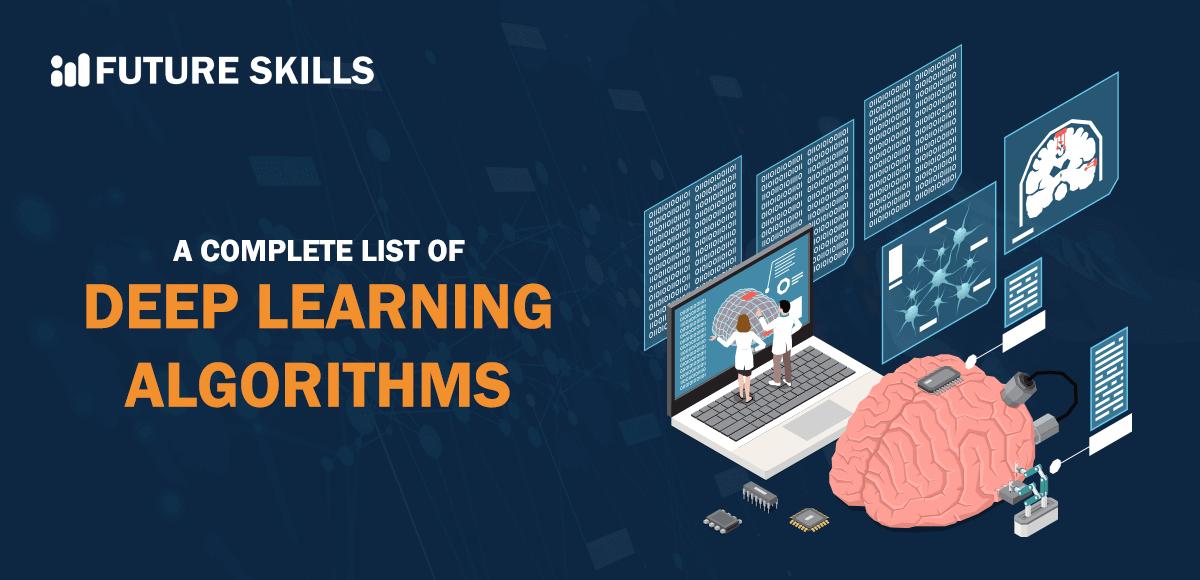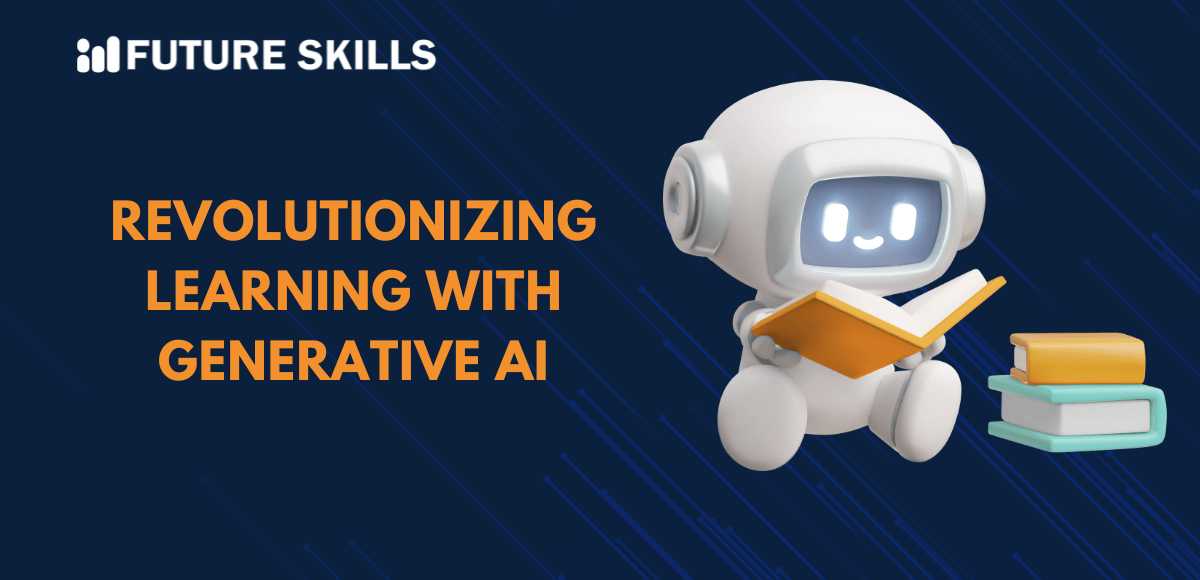Deep learning has gained a significant amount of popularity alongside machine learning and AI. It is a type of machine learning or a subdomain of machine learning that utilizes artificial neural networks for learning from data. Artificial neural networks draw inspiration from the human brain and can help solve different types of problems, including speech recognition, image recognition, and natural language processing. Your curiosity about the deep learning algorithms list has brought you here.
Therefore, it is important to understand the significance of deep learning and how different algorithms improve deep learning. Let us learn more about the most important deep learning algorithms and their working mechanisms.
Level up your AI skills and embark on a journey to build a successful career in AI with our Certified AI Professional (CAIP)™ program.
What are Deep Learning Algorithms?
Before you find more information about deep learning algorithms, you should learn about their purpose. You can use answers to the question “What are the machine learning algorithms?” to understand deep learning algorithms. Just like machine learning algorithms, deep learning algorithms go through training on large datasets.
The algorithms then learn how to connect features in the data with the relevant labels. For example, the algorithm would learn to relate specific features in an image to the correct label in image recognition tasks. After training a deep learning algorithm, you can use it to make predictions on new data. For instance, deep learning algorithms trained to recognize images of cars can be used to identify cars in new images.
The similarity between deep learning and machine learning is evident in the fact that both of them are subdomains of artificial intelligence. However, machine learning is a broader term that includes many other techniques like deep learning. Machine learning algorithms are trained by using large datasets with labelled data.
On the other hand, a deep learning algorithms list would showcase that they are trained on massive collections of unlabeled data. Machine learning serves as an ideal choice for tasks such as natural language processing, image recognition and speech recognition. On the contrary, deep learning algorithms are useful for tasks that require pattern recognition with higher accuracy, such as object detection and image classification.
Level up your ChatGPT skills and kickstart your journey towards superhuman capabilities with Free ChatGPT and AI Fundamental Course.
Significance of Neural Networks in Deep Learning
Deep learning leverages artificial neural networks to power its algorithms. It can use artificial neural networks to learn insights from data. You can understand popular deep learning models by reflecting on the working of artificial neural networks. Neural networks utilize different layers of interconnected nodes, with each node taking responsibility for learning a specific feature.
Let us assume that you have an image recognition task in which the first layer of nodes can learn how to identify edges. The second layer in the task would learn how to identify shapes, and the final layer would learn how to identify objects.
The network learns continuously, and the weights on the connection between nodes are adjusted continuously for better classification of data. Deep learning algorithms can go through training by using different techniques, such as supervised learning, reinforcement learning, and unsupervised learning. After training a neural network, you can use it to make predictions with the new data.
Excited to understand the crucial requirements for developing responsible AI and the implications of privacy and security in AI, Enroll now in the Ethics of Artificial Intelligence (AI) Course
What are the Top Deep Learning Algorithms?
Deep learning models use different types of algorithms. It is important to note that one specific network cannot be considered perfect. Therefore, you can find the best deep learning algorithms according to specific tasks.
You can choose the ideal algorithms by developing an in-depth understanding of different primary algorithms. Here is an outline of deep learning algorithms that you must know about before diving deeper into the AI landscape.
-
Convolutional Neural Networks
Convolutional Neural Networks, or CNNs, are a unique type of artificial intelligence that has been predominantly used for understanding visual data, including videos and images. CNNs can help replicate the visual processing ability of the brain to identify features, objects, and patterns in images.
Convolutional Neural Networks are popular deep learning models for image recognition, computer vision and object detection tasks. CNNs have the ability to learn hierarchical representations. On the other hand, convolutional neural networks can be computationally intensive, with the requirement for large amounts of data for effective training.
-
Recurrent Neural Networks
Recurrent Neural Networks help in creating a specific variant of neural network architecture that can process sequential data. RNNs retain information over a longer duration of time by using loops in the network. Have you ever wondered how Google automatically completes the sentence you type in a search query?
Recurrent Neural Networks are a prominent addition to deep learning algorithms because of their features that help manage sequences of different lengths. In addition, RNNs can also capture temporal dependencies in data for auto-completion. The setbacks of recurrent neural networks draw attention towards the risks of exploding or vanishing gradients. These types of gradients can create challenges for capturing long-term dependencies.
Enroll now in the AI for Business Course to understand the role and benefits of AI in business and the integration of AI in business.
-
Generative Adversarial Networks
Generative Adversarial Networks, or GANs, are one of the top responses to “What are the machine learning algorithms?” in the AI landscape. These powerful machine learning models play a crucial role in defining the structure of deep learning algorithms. The architecture of GANs includes two interconnected networks, such as a discriminator and a generator. Both networks can work collectively through competition to generate synthetic data and improve their capability to differentiate between fake and real data.
The most prominent advantage of generative adversarial networks is the flexibility for creating high-quality and realistic synthetic data. On top of that, GANs have found applications in the fields of data augmentation, art generation, and image editing. However, GANs are susceptible to collapses and can present crucial challenges in the training process.
-
Deep Belief Networks
The list of top deep learning algorithms would also include deep belief networks. Deep belief networks feature complex neural networks that include multiple layers with probabilistic models. They work through the integration of supervised and unsupervised learning techniques. Deep belief networks are ideal for tasks that require classification or feature learning.
Such types of deep learning algorithms are generally used for hierarchical representations alongside the pre-training of deep neural networks. For example, deep belief networks are effective for unsupervised pre-training of deep neural networks, such as restricted Boltzmann machine layers. Deep belief networks have major pitfalls in the requirement of more computation resources and slow training speed.
-
Multilayer Perceptrons
Multilayer Perceptrons, or MLPs, are an integral aspect in the domain of deep learning. MLPs are a fundamental variant of artificial neural networks that include different layers of interconnected neurons. Multilayer Perceptrons can process information through a feedforward approach, guided from input to output stages, through hidden layers. Therefore, MLPs are the best deep learning algorithms for learning complex relationships and tasks such as classification and regression.
MLPs are extremely versatile and have the ability to approximate any function with the right amount of neurons and layers. The problem with MLPs is the concern of overfitting on small datasets alongside issues in capturing complex patterns in data without adequate depth.
-
Feedforward Neural Networks
Feedforward Neural Networks, or FNNs, are another fundamental type of artificial neural network or ANNs. The unique detail of FNNs is the unidirectional movement of information from the input layer to the output layer through the hidden layers. The versatility of FNNs plays a role in their favour, and they can approximate different types of functions. Therefore, feedforward neural networks are commonly used to address regression and classification issues in machine learning and pattern recognition.
The most important traits of FNNs include their simple architecture, suitability for supervised learning tasks and easier training. However, feedforward neural networks might experience complications with sequential or temporal data.
Want to gain practical skills in using OpenAI API and implementing API calls to facilitate LLM interactions, Enroll now in the Certified Prompt Engineering Expert (CPEE)™ Certification.
-
Long Short-Term Memory Networks
Long Short-Term Memory Networks, or LSTMs, can work as a sophisticated variant of recurrent neural network architecture. You cannot complete a deep learning algorithms list without including LSTMs.
The deep learning models are tailored to resolve the vanishing or exploding gradient problems in conventional recurrent neural networks. LSTMs stand out for their capabilities to learn and remember long-term dependencies in sequential data through control over the flow of information through ‘gates’. However, Long Short-Term Memory Networks are more expensive than conventional RNNs due to the requirement of additional hardware.
-
Radial Basis Function Networks
Another notable subdomain of artificial neural networks among deep learning algorithms is the Radial Basis Function Networks or RBFNs. The working mechanism of RBFNs involves the use of radial basis functions as activation functions in the hidden layers.
RBFNs are popular deep-learning models for tasks that involve function approximation and classification, particularly with data that shows clear cluster boundaries. On the other hand, RBFNs can present setbacks with the use of higher-dimensional data. Radial Basis Function Networks could also need careful tuning of the quantity of radial basis functions.
Final Words
Deep learning has massive potential to transform industries, society, and our everyday lives. You can tap into the impressive potential of deep learning by leveraging the best deep learning algorithms to your advantage. The benefits of understanding deep learning algorithms point to the possibilities for the fusion of deep learning with other technologies. Refinements and innovation in deep learning algorithms can help in creating a more efficient and adaptable artificial intelligence ecosystem. Learn more about the fundamentals of deep learning now.





